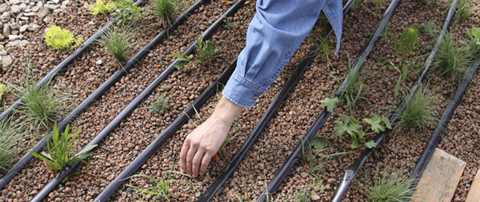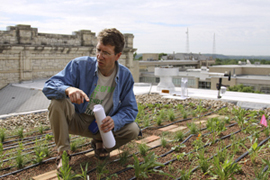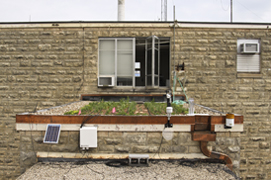The garden up top:
K-STATE PROFESSORS TEST NATIVE PLANTS AS ROOFING ALTERNATIVE

Two faculty members from K-State's College of Architecture, Planning and Design have taken their garden to new heights.
R. Todd Gabbard, assistant professor of architecture, and Lee Skabelund, an assistant professor of landscape architecture, have installed an experimental green roof -- or living roof -- over a third-floor breezeway in Seaton Hall's west wing.
The garden won't provide heirloom tomatoes or cut flowers. Instead, it aims to assess how such a roof can reduce the urban heat load and control runoff from the region's intense thunderstorms.
 At the garden, black plastic irrigation lines contrast with green rows of native plants and the reddish soil substitute that overlies layers of root barrier and waterproofing. New copper flashing, left over from a project elsewhere on the K-State campus, reflects the morning sun and an anemometer spins in the breeze. The anemometer and a bundle of coaxial cables hint at how closely monitored this fledging garden will be. Fluttering pink surveyor's flags mark temperature sensors, which every five minutes send a fresh set of readings from various soil depths to the on-site recording station.
At the garden, black plastic irrigation lines contrast with green rows of native plants and the reddish soil substitute that overlies layers of root barrier and waterproofing. New copper flashing, left over from a project elsewhere on the K-State campus, reflects the morning sun and an anemometer spins in the breeze. The anemometer and a bundle of coaxial cables hint at how closely monitored this fledging garden will be. Fluttering pink surveyor's flags mark temperature sensors, which every five minutes send a fresh set of readings from various soil depths to the on-site recording station.
The garden mixes 14 grasses and other plants native to Kansas inside a border of sedum, a shallow-rooted succulent. Even at its deepest point, the roof offers only about six inches of growing medium, so a big question for the experiment is simply about plant survival. After two growing seasons, the irrigation will be removed and the 200-plus plants will have to make it on their own.
Skabelund said that this is the first such living roof in the Flint Hills since settlers left behind the sod house. Larger variations on this theme have been installed in settings as diverse as Seattle City Hall and in Salt Lake City, where a 70,000-square-foot meadow covers a conference center. But green roofs are still uncommon; since most are flat, most of these roofs remain invisible to pedestrians.
 Conventional roofs, whether a rolled commercial type or a residential installation of three-tab shingles, have two weaknesses: they soak up heat and shed water too quickly.
Conventional roofs, whether a rolled commercial type or a residential installation of three-tab shingles, have two weaknesses: they soak up heat and shed water too quickly.
The project will provide research to answer questions about the life-cycle costs of green roofs and whether plants can survive long-term without irrigation, according to Gabbard and Skabelund.
Funds for the Seaton Hall green roof project came from donations and a mini-grant from Kansas WaterLINK, a Water Quality, Restoration and Protection Service learning grant awarded to K-State by the Kansas Department of Health and Environment from U.S. Environmental Protection Agency funds. A majority of the garden's materials also were donated.
Time and effort were also donated by several students and faculty in the colleges of Architecture, Planning and Design, Agriculture and Engineering, as well as employees in the Division of Facilities. External partners included Derbigum and Performance Roofing Systems, Danker Roofing and American Hydrotech.
Skabelund and Gabbard are now seeking funding and donations to convert two, small neighboring roofs to living status.